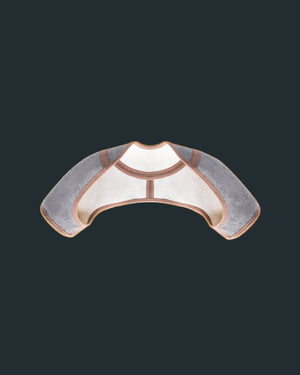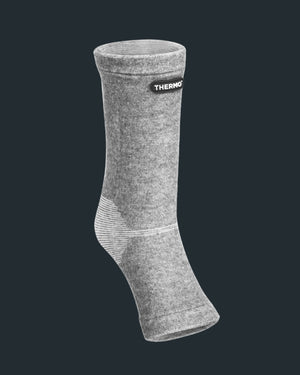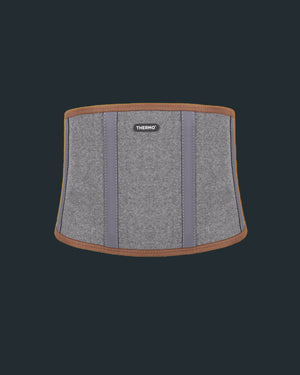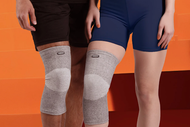Running is a high-impact activity that demands a lot from the knees, making protection and support vital for both casual joggers and seasoned marathoners.
Running is a high-impact activity that demands a lot from the knees, making protection and support vital for both casual joggers and seasoned marathoners.
A knee brace for running can be a game-changer, providing stability, enhancing performance, and preventing injuries. However, with so many options available, selecting the appropriate brace may seem overwhelming.
This guide is crafted to streamline the process, equipping you with the knowledge needed to find a knee brace that complements your running journey to ensure optimal knee health and keep you on track to achieve your goals.
Let’s dive in!
Understanding Knee Braces as a Runner
Knee braces are designed to offer various kinds of support to the knee during physical activities. They achieve this through a combination of compression, stabilization, and sometimes hinged support mechanisms.
Compression aids in reducing swelling and improving blood circulation, which can speed up recovery from workouts or minor injuries. But be careful about choosing a high compression brace above your needs, as it might restrict your mobility and circulation.
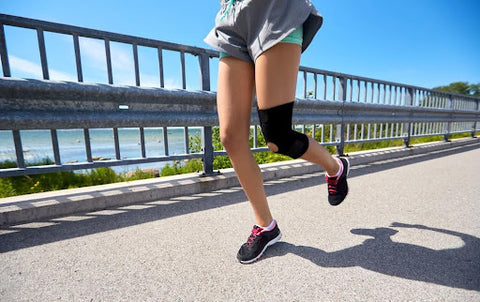
Stabilization is another key feature, where the braces provide stronger support to prevent unnatural or harmful movements of the knee.
This is particularly important for runners who may have weak or previously injured knees, where the additional support can help your knee move correctly throughout the running motion.
For those with more severe injuries or instabilities, a hinged knee brace can offer a higher level of support.
It comes with metal or plastic supports on the sides of the brace, which are connected by hinges that allow for natural knee movement while preventing harmful or excessive movement.
Benefits of Wearing a Knee Brace for Running
The primary benefits of wearing a knee brace for running include:
-
Injury Prevention: By limiting the movement of the knee to a safe range, braces can help prevent ligament damage, such as sprains or tears, especially in runners with previous knee issues.
-
Knee Pain Management: If you suffer from chronic conditions like arthritis or a runner's knee, a knee brace can alleviate knee pain by distributing weight away from the affected parts of the knee.
-
Enhanced Confidence: Knowing that your knees are supported can boost your confidence, allowing you to perform better when you play sports.
-
Recovery Support: Following an injury, knee braces can play a crucial role in a runner's rehabilitation process by providing extra support as they gradually return to their regular running routine.
-
Proprioceptive Feedback: Knee braces can improve proprioception, and the body's ability to sense movement within each knee, which can enhance movement patterns and reduce the risk of re-injury.
How to Choose the Right Knee Brace for Running
Here are the most important factors to consider before buying a knee brace for running:
Support Level
When selecting a knee brace, assess the level of support needed based on your knee health and running intensity.
Light support is suited for minor knee pain and strains, while advanced support with hinges is ideal for unstable or recovering knees. Ensure the support level matches your condition without impeding natural movement.
Material
The material of a knee brace should be a balance between robust support and comfortable wear. Neoprene is common for its elasticity and warmth, which can soothe sore knees.
However, for those with sensitive skin or allergies, a hypoallergenic fabric may be necessary to prevent an unwanted reaction or other irritation during extended use.
Size and Fit
A knee brace must fit snugly to be effective. Too tight, and it can impede circulation; too loose, and it won't provide adequate knee support.
Many brands offer a range of sizes, and some are adjustable. Measure your leg according to the manufacturer’s guidelines to ensure a secure and comfortable fit.
Durability
Running can put significant strain on a knee brace, so durability is essential. Look for knee sleeves made from high-quality materials that can withstand regular use and the rigors of washing.
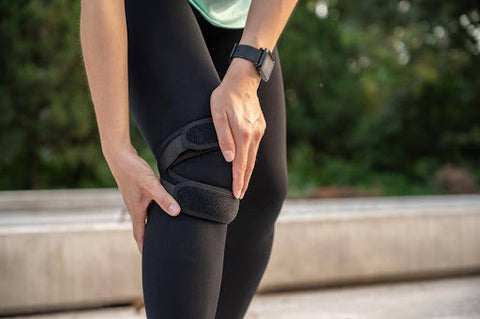
Reinforced stitching and robust fastening systems contribute to longevity, giving you a better return on your investment.
Breathability and Moisture-Wicking
Comfort during a run isn't just about the fit—it's also about keeping your knee dry and cool.
A knee brace with breathable fabric and moisture-wicking properties will help to regulate temperature and redirect sweat away from the knee, reducing the risk of chafing and skin irritation, especially on longer runs.
Proper Usage and Maintenance of Knee Braces
How to Wear a Knee Brace Correctly
Ensure the brace sits comfortably above and below the knee without pinching or slipping. Secure any straps or closures evenly to apply consistent pressure, avoiding overly tight adjustments that can restrict circulation.
Building Tolerance to a Knee Brace
Start by wearing the brace for short periods during low-impact activities, gradually increasing the time and intensity. This allows your body to adapt to the brace and can help prevent discomfort during longer runs.
Cleaning and Maintenance Tips
Regularly clean your knee brace following the manufacturer’s instructions, usually with mild soap and water, but avoid harsh chemicals and high heat from dryers, as they can degrade the material.
Also, inspect the brace for signs of wear and tear routinely to maintain optimal knee support and hygiene.
Common Mistakes to Avoid
Choosing the Wrong Size
Selecting a knee strap that's too large or too small undermines its effectiveness, leading to insufficient knee support or restricted blood flow. Always use the sizing chart provided by the manufacturer and double-check your measurements before purchasing.
Over-reliance on Braces
Relying solely on knee straps can lead to weakened muscles over time. They should complement a balanced strength and conditioning program, not replace it. So use braces as a tool for support, not as a crutch for stability.
Ignoring Underlying Issues
Knee braces can mask knee pain but don't address the root cause of knee problems. It's important to consult a healthcare professional for a proper diagnosis and treatment plan, rather than self-medicating for the long term with a knee brace.
Wrap Up
Finding the perfect knee brace for running is a balance of understanding your needs and ensuring proper usage.
By carefully choosing a brace that offers the right support, fit, and comfort, and maintaining it well, you can safeguard your knees and enhance your running performance for miles to come.
If you are looking for the highest quality knee braces, Thermo Recovery Wear has you covered.
Browse our offer today and find the perfect recovery wear that suits your needs!

